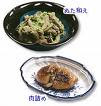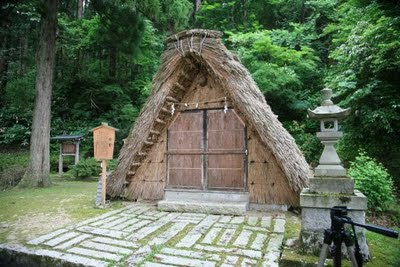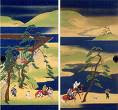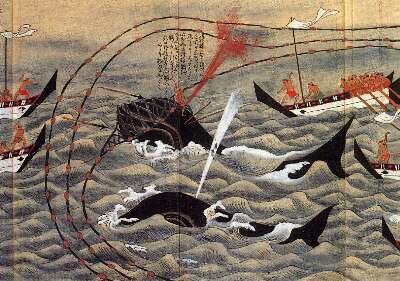::::::::::::::::::::::::::::::::::::::::::::::::::::::::::::::::::::::::::::::::::::::::::::::::::::
Straw (wara)
***** Location: Japan
***** Season: Various, see below
***** Category: Plant, humanity
*****************************
Explanation
Straw is used for many things in Japan.

wayside shrine made from straw
Here let us look at the kigo.
We have straw from wheat (wara) and rice plants.
:::::::::::::::::::::::::::::::::::::::::::::::::::::::::::::::::::::::::::::::::::::::::::::::::::
kigo for spring
observance kigo for early spring

warauma hiki, wara-uma hiki 藁馬曳き (わらうまひき)
leading a straw horse
In Tozawa, Nagano 戸沢のわら馬曳き
Straw horses mounted on sledges with wheels are pulled down from the mountains in the west, to pray at the wayside deities (doosojin) for protection from fire and other accidents and for good health in the coming year.
On February 8, the day of "koto hajime".
. . . CLICK here for Photos !
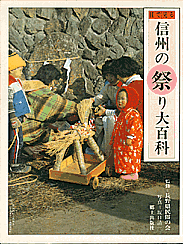
Book about the festivals of Shinshu (Nagano) in the 12 months. The title shows the straw horse festival.
. Doosojin 道祖神 the Wayside Gods
.................................................................................
all spring
suwara suzume 巣藁雀(すわらすずめ)
sparrow nest made of straw
:::::::::::::::::::::::::::::::::::::::::::::::::::::::::::::::::::::::::::::::::::::::::::::::::::
kigo for summer
early summer
mugiwara 麦藁 (むぎわら) straw from wheat
... 麦稈(むぎわら)
mugiwarabue, mugiwara bue 麦藁笛(むぎわらぶえ)
flute from straw
... 麦稈笛(むぎわらぶえ)
mid-summer
makiwarabune 巻藁船(まきわらぶね)ship to transport straw bundles
(during the Atsuta festival 熱田祭 (あつたまつり))
mugiwara kago 麦藁籠 (むぎわらかご) straw basket
... 麦稈籠(むぎわらかご)
mugiwara haze 麦藁鯊 (むぎわらはぜ) "straw goby" fish
goby caught in autumn

mugiwara dai 麦藁鯛 (むぎわらだい) "straw sea bream"
caught in autumn, after laying eggs
... waradai, wara-dai 麦鯛
mugiwara dako 麦藁章魚 むぎわらだこ "octopus during straw season"
... mugiwaradako 麦藁蛸(むぎわらだこ)
:::::::::::::::::::::::::::::::::::::::::::::::::::::::::::::::::::::::::::::::::::::::::::::::::::
kigo for late autumn
shinwara, shin wara 新藁 (しんわら) new straw
kotoshi wara 今年藁(ことしわら) straw of this year

warazuka 藁塚 (わらづか) mound of straw
. . . nio にお、wara nio 藁にお(わらにお)、waraguru 藁ぐろ(わらぐろ)
warako zumi 藁こづみ(わらこづみ)
tawara ami 俵網 (たわらあみ) making straw bags
wara kinuta 藁砧(わらきぬた)mallet for pounding straw
Fulling block (kinuta)
mugiwara tonbo 麦藁蜻蛉(むぎわらとんぼ)"wheat straw" dragonfly
. . . CLICK here for Photos !
:::::::::::::::::::::::::::::::::::::::::::::::::::::::::::::::::::::::::::::::::::::::::::::::::::
kigo for winter
wara shigoto 藁仕事 (わらしごと) working with straw
wara utsu 藁打つ(わらうつ)hitting straw
with a wooden mallet, to make it softer
nawa nau 縄綯う(なわなう)making a rope
tawara amu 俵編む(たわらあむ)making straw bags
(also in late autumn)
mushiro oru 筵織る(むしろおる)weavint straw mats
Mushiro for summer
waragutsu amu 藁沓編む(わらぐつあむ)weaving straw boots
waragutsu 藁沓(わらぐつ)straw shoes for winter
kamasu oru 叺織る(かますおる)weaving a straw bag
Straw bag (kamasu) topic for haiku
:::::::::::::::::::::::::::::::::::::::::::::::::::::::::::::::::::::::::::::::::::::::::::::::::::
kigo for the New Year
fukuwara 福藁 (ふくわら) straw for good luck
fukuwara shiku 福藁敷く(ふくわらしく)
fukusa wara ふくさ藁(ふくさわら)
New straw that is placed at the entrance and in the garden of a mansion. It serves to purify the place for the coming year and is a gesture of respect for the visitors on the New Year.
kazariwara, kazari-wara 飾藁(かざりわら)straw for decorations
especially shimenawa ropes
Shimenawa 注連縄
wara gooshi 藁盒子 (わらごうし) small straw container with a lid
... saiwai kago 幸籠(さいわいかご)"good luck basket"
*****************************
Worldwide use
*****************************
Things found on the way
aramakizake 新巻鮭(あらまきざけ)one whole salmon perserved in straw after marinating in vinegar.
WASHOKU
salmon food
:::::::::::::::::::::::::::::::::::::::::::::::::::::::::::::::::::::::::::::::::::::::::::::::::::::


warazaiku 藁細工 things made of straw
straw works, straw crafts
Winter was the time for the farmers to make many useful things of straw in the olden times. Each villag had its specialist and the housewifes learned from him and made many things themselves. Toys for the children were also made of straw.
Stroharbeiten

o-mikiguchi おみきぐち / 神酒口
decorations for sake bottles as offerings for the New Year
:::::::::::::::::::::::::::::::::::::::::::::::::::::::::::::::::::::::::::::::::::::::::::::::::::::
. Wara ningyoo 藁人形 straw dolls for curses .
*****************************
HAIKU
新藁の出初めて早き時雨哉
shinwara no desomete hayaki shigure kana
The new rice-straw
Is coming out, but already
The wintry shower is starting.
Tr. Oseko
Written in 元禄7年, Basho age 51, at Iga Ueno, at the home of Izen.
. Matsuo Basho 松尾芭蕉 - Archives of the WKD .
. Basho at the home of Kubota Izen 窪田意専 .

quote
Winter season is coming soon. Autumn wind is blowing, the fields that harvest is over, there is a landscape to feel lonely. In places, are stacked straw. In Japan, this is very important straw.
Straw, to make various things, he was using. Autumn landscape and lonely, in this clause, Basho's view of nature are expressed.
Sweet, representing the leaves of ginkgo had come down on top of the straw.
source : kikyou0123
haika 俳菓 Haiku Sweets
:::::::::::::::::::::::::::::::::::::::::::::::::::::::::::::::::::::::::::::::::::::::::::::::::::::::
fukuwara ya gomi sae kesa no utsukushiki
new auspicious straw -
this morning even the dirt
looks beautiful
Chiyo-Ni (Chiyoni), Kaga no Chiyo jo (1703-1775)
(tr. Gabi Greve)
:::::::::::::::::::::::::::::::::::::::::::::::::::::::::::::::::::::::::::::::::::::::::::::::::::::::
The giant straw sculptures of Japan
straw sculptures of the Wara Art Festival in Niigata Prefecture

CLICK for more samples .
Look at more photos:
- source : en.rocketnews24.com
*****************************
Related words
***** Bagworm (minomushi - "straw raincoat bug") Japan. Case moth, basketworm
***** Geta, wooden Japanses sandals Japan. Straw sandals (zoori)
***** Hat, Straw hat, hood (kasa, zukin, booshi) Japan Worldwide
***** Sandeel: KAMASU : straw back, tobacco pouch, Pacific sandeel (Ammodytes personatus) Japan
***** Strawberries Cranberries
***** Straw mats (thick: tatami. thin: goza) Japan
. SAIJIKI -
Observances in Spring
. mugiwarazaiku 麦わら細工 handicraft from wheat straw .
:::::::::::::::::::::::::::::::::::::::::::::::::::::::::::::::::::::::::::::::::::::::::::::::::::::::::::::::::::::::::::
[ . BACK to DARUMA MUSEUM TOP . ]
[ . BACK to WORLDKIGO . TOP . ]
:::::::::::::::::::::::::::::::::::::::::::::::::::::::::::::::::::::::::::::::::::::::::::::::::::::::::::::::::::::::::::



